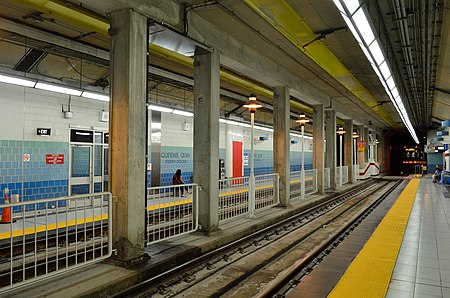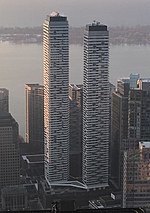Queens Quay station

Queens Quay is an underground streetcar station of the Toronto streetcar system in Toronto, Ontario, Canada. It is the only underground streetcar station that is not part of or connected to a Toronto subway station (Union, Spadina, and St. Clair West subway stations have underground stations for streetcars as well). It was opened in 1990 as part of the former Harbourfront LRT route. The station is now served by the 509 Harbourfront, 510 Spadina daytime routes and the 310 Spadina night route.The station is named after Queens Quay, an adjacent street skirting Toronto's waterfront. The station's internal signage bears the subtitle "Ferry Docks", a reference to the nearby Jack Layton Ferry Terminal for the Toronto Island ferries that provide pedestrian access to the Toronto Islands. This station did not open at the same time as the rest of the Harbourfront line it served, due to disputes regarding direct access to nearby businesses that eventually fell through. Additionally, after the station did open, the "FERRY DOCKS" subtitle was not yet present.
Excerpt from the Wikipedia article Queens Quay station (License: CC BY-SA 3.0, Authors, Images).Queens Quay station
Bay Street, Old Toronto
Geographical coordinates (GPS) Address External links Nearby Places Show on map
Geographical coordinates (GPS)
| Latitude | Longitude |
|---|---|
| N 43.64151 ° | E -79.37704 ° |
Address
Queens Quay - Island Ferry Docks
Bay Street
M5J 2R8 Old Toronto
Ontario, Canada
Open on Google Maps










